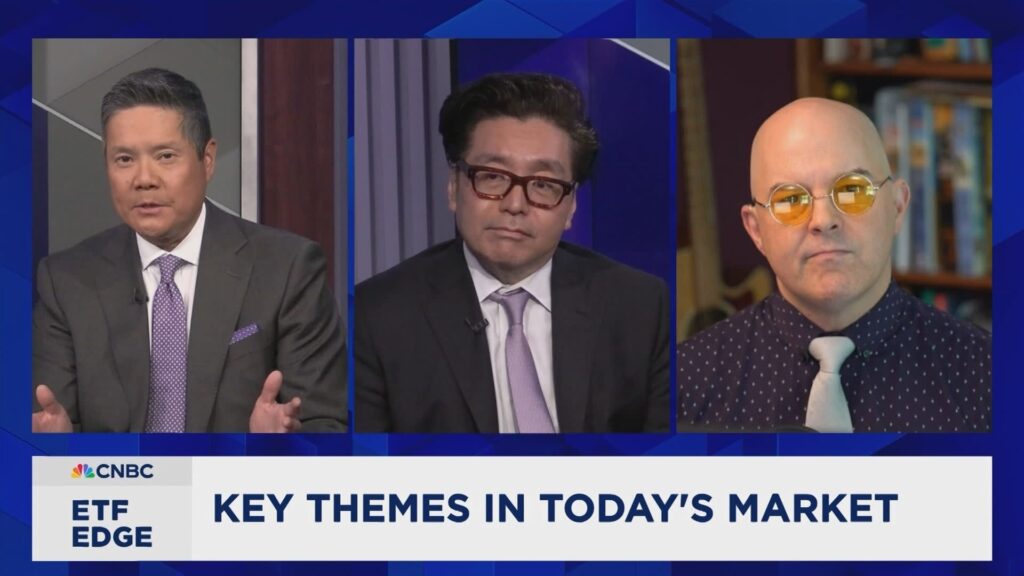In a rapidly evolving financial landscape, the intersection of cryptocurrency and exchange-traded funds (ETFs) is a topic of intense discussion. Recently, Tom Lee, Chief Investment Officer and Portfolio Manager at Fundstrat Capital, and Dave Nadig, an independent ETF expert, shared their insights on CNBC with Dominic Chu. Their conversation delved into the current position of crypto within the ETF space and the dual narratives influencing its trajectory.
The dialogue between Lee and Nadig highlighted a critical juncture for cryptocurrencies as they strive to find a stable footing within the ETF market. The experts noted that crypto is currently navigating between the narratives of innovation and regulation, both of which significantly impact its integration into traditional financial instruments like ETFs.
The Dual Narratives: Innovation vs. Regulation
Cryptocurrencies have long been celebrated for their innovative potential, offering decentralized solutions and new financial opportunities. However, this innovation comes with its own set of challenges, particularly in terms of regulatory scrutiny. Lee and Nadig emphasized that while innovation drives interest and investment in crypto, regulatory concerns can impede its progress.
“Regulation is the elephant in the room,” Nadig stated, highlighting the cautious approach regulators are taking. This cautiousness stems from the volatility and security issues that have historically plagued the crypto market. As such, the regulatory landscape remains a significant factor in determining how and when cryptocurrencies can be fully integrated into ETFs.
Current Market Dynamics and ETF Integration
The current market dynamics present both opportunities and obstacles for crypto’s role in ETFs. On one hand, the increasing institutional interest in cryptocurrencies suggests a growing acceptance and potential for integration. On the other hand, the volatility of crypto assets poses challenges for ETF managers who seek to offer stable and reliable investment products.
According to Lee, “The interest from institutional investors is a positive sign, but the volatility of crypto assets remains a hurdle.” This sentiment reflects the broader market’s cautious optimism, as stakeholders weigh the benefits of innovation against the risks of volatility and regulatory hurdles.
Historical Context and Comparisons
To understand crypto’s potential role in ETFs, it’s useful to look at historical parallels. The integration of gold into ETFs serves as a pertinent example. Initially, gold faced skepticism due to its volatility and lack of yield. However, over time, it became a staple in ETF offerings, providing a model for how crypto might eventually be assimilated.
Experts draw comparisons between the early days of gold ETFs and the current state of crypto ETFs, suggesting that patience and regulatory clarity could pave the way for crypto’s broader acceptance. “The journey of gold ETFs offers valuable lessons for crypto,” Lee remarked, underscoring the importance of strategic patience and regulatory engagement.
Future Prospects and Strategic Considerations
Looking ahead, the future of crypto in the ETF space will likely hinge on several key factors: regulatory developments, market maturity, and technological advancements. As regulators continue to develop frameworks that address security and compliance concerns, the path for crypto ETFs may become clearer.
Moreover, as the market matures, with improved infrastructure and reduced volatility, crypto assets could become more attractive to ETF managers and investors alike. Technological advancements, such as enhanced blockchain security and scalability, will also play a crucial role in shaping the future landscape.
In conclusion, the integration of crypto into ETFs is a complex yet promising endeavor. As Lee and Nadig’s discussion illustrates, the journey is fraught with challenges but also ripe with opportunity. The coming years will be pivotal in determining how these digital assets can be harmoniously woven into the fabric of traditional financial instruments.
About The Author
 BayCare’s St. Joseph’s Hospital Achieves Teaching Hospital Status in Florida
BayCare’s St. Joseph’s Hospital Achieves Teaching Hospital Status in Florida Tesla’s Delivery Forecasts: Wall Street’s Tepid Outlook Amidst Strategic Shifts
Tesla’s Delivery Forecasts: Wall Street’s Tepid Outlook Amidst Strategic Shifts Top UK Hospital Trusts Excel in Cancer Treatment Amid NHS Challenges
Top UK Hospital Trusts Excel in Cancer Treatment Amid NHS Challenges Spain Commits to NATO Spending Target Amid Global Security Concerns
Spain Commits to NATO Spending Target Amid Global Security Concerns Netflix’s “Shark Whisperer” Dives Into Controversial Waters
Netflix’s “Shark Whisperer” Dives Into Controversial Waters